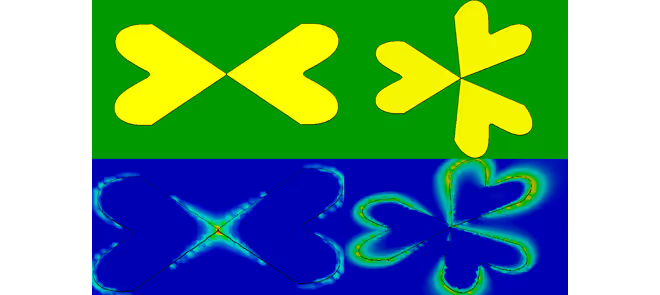A Novel Plasmonic Nanoantenna-Based Sensor for Illicit Materials and Drugs Detection
Illegal drug trafficking and the explosives used for terrorism and war have created a demand for rapid and reliable methods for identifying threats in security and defense applications. This study presents an innovative approach to detecting illicit materials and drugs using terahertz (THz) spectroscopy, leveraging two novel plasmonic nanoantenna designs: the butterfly and shamrock. These nanoantennas work by exploiting surface plasmon resonance (SPR), which amplifies light-matter interactions at nanometric scales, significantly enhancing the sensitivity and specificity in detecting molecular signatures.
The proposed designs stand out for their ability to detect substances non-destructively across specific THz frequencies. This makes them ideal for security, biomedical diagnostics, and environmental monitoring applications.
The butterfly nanoantenna consists of two symmetrical gold arms on a silicon-gold substrate. They are optimized to resonate at 2.1, 3.6, and 5.1 THz. Its design enhances electromagnetic field interaction, achieving a high enhancement factor of 6.09×105 and excellent directivity.
Inspired by the butterfly nanoantenna design, a novel geometrical shamrock nanoantenna with three symmetrical arms was introduced. It extended detection to 1.9 and 3.3 THz. Together, these designs cover a comprehensive range of THz frequencies associated with the absorption peaks of substances such as TNT (trinitrotoluene), MDMA (methylenedioxymethamphetamine), and SEMTEX-H.
The effectiveness of the butterfly and shamrock nanoantennas, showcasing their superior field enhancement, reflectivity, and directivity, was demonstrated with the simulations conducted with CST Studio Suite 2023. Both designs were further validated experimentally using fabricated 2×2 nanoantenna arrays. Results confirmed their ability to detect molecular traces accurately and reliably, even in minute quantities. Unlike conventional bowtie nanoantennas, which struggle to achieve broad frequency coverage, the butterfly and shamrock designs provide unparalleled performance for multi-frequency detection.
The nanoantennas have a wide range of applications. They enable the precise identification of explosives (like TNT, HMX, SEMTEX-H) and narcotics (like MDMA, cocaine, and heroin) in the security and defense sectors, which can be detected by matching their specific resonant frequencies with those of the nanoantennas. In biomedical research, the potential of nanoantennas extends to identifying cancer-related DNA and chemotherapeutic drugs. This versatility underscores their utility in both healthcare diagnostics and pharmaceutical development. Additionally, their integration with microfluidic systems makes them invaluable for environmental monitoring, where continuous and real-time analysis of samples is crucial for tracking pollutants or hazardous materials.
A key strength of these nanoantennas lies in their simplicity and adaptability. They function as "naked sensors," requiring minimal sample preparation, and integrate seamlessly with Fourier-transform infrared (FTIR) spectroscopy for enhanced analysis. Accurate molecular identification can be achieved without destructive testing by placing a few drops of a prepared sample on the sensor. This method simplifies the detection process and ensures high precision, making it suitable for sensitive applications.
The butterfly and shamrock nanoantennas significantly advance plasmonic sensing technology. Their innovative geometries and ability to detect a wide range of substances with exceptional sensitivity position them as groundbreaking tools for future applications. Whether in combating illicit drug trafficking, advancing cancer diagnostics, or enhancing environmental monitoring, these nanoantennas promise to redefine detection capabilities in critical domains.




